Media contact: Yvonne Taunton
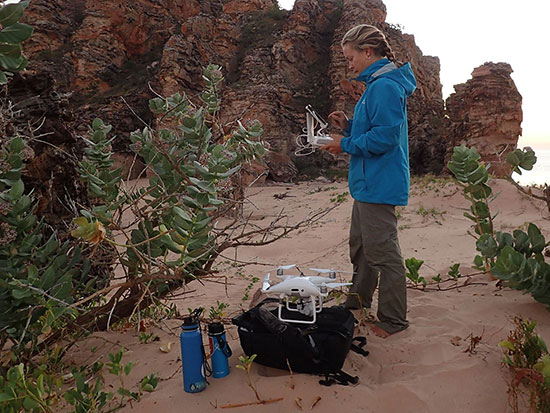 The sky was blue, the water even more so and the rocky headlands were postcard-perfect. But Elizabeth Bevan, flying her Phantom 4 Pro quadcopter over the Timor Sea on the way to a turtle nesting site, never looked up. Neither did the saltwater crocodile she passed over, although the slight movement of his head made it clear that he wasn’t happy about the situation. “He was upset,” recalls Bevan, a UAB graduate student who spent a rugged three months in Australia last summer, doing research for her dissertation on a series of remote islands in Western Australia and the Northern Territory. (She received her Ph.D. from the UAB College of Arts and Sciences Department of Biology in spring 2018.)
The sky was blue, the water even more so and the rocky headlands were postcard-perfect. But Elizabeth Bevan, flying her Phantom 4 Pro quadcopter over the Timor Sea on the way to a turtle nesting site, never looked up. Neither did the saltwater crocodile she passed over, although the slight movement of his head made it clear that he wasn’t happy about the situation. “He was upset,” recalls Bevan, a UAB graduate student who spent a rugged three months in Australia last summer, doing research for her dissertation on a series of remote islands in Western Australia and the Northern Territory. (She received her Ph.D. from the UAB College of Arts and Sciences Department of Biology in spring 2018.)

The incident got Bevan thinking. She had been using drones to gather data on sea turtle behavior for several years, and they hadn’t seemed to mind the buzzing vehicle overhead. Then again, “turtles don’t seem to be disturbed by the drone,” she says. But the sea crocodile had clearly been upset by the drone’s presence. So was the colony of terns that Bevan sometimes flew over during her research flights. She decided to investigate systematically, flying over the terns, crocodiles and several species of sea turtles at various heights to document their reactions. In March, PLoS ONE published her paper on the subject, “Measuring behavioral responses of sea turtles, saltwater crocodiles, and crested terns to drone disturbance to define ethical operating thresholds.”
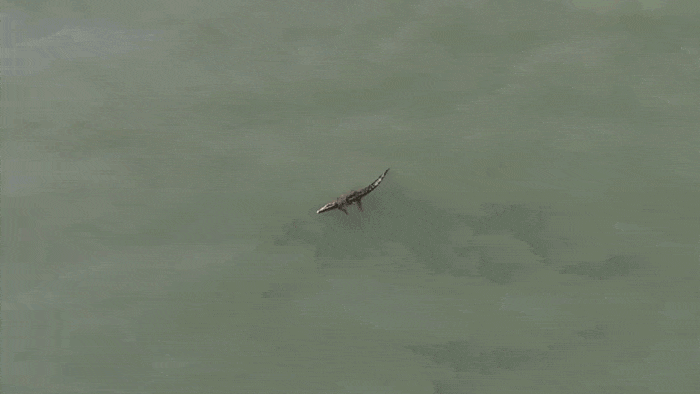 Tell-tale head movement alerted Bevan that her drone had disturbed a basking saltwater crocodile. The incident led to her paper investigating optimal drone altitude's for observing various species. Original video footage courtesy Elizabeth Bevan.
Tell-tale head movement alerted Bevan that her drone had disturbed a basking saltwater crocodile. The incident led to her paper investigating optimal drone altitude's for observing various species. Original video footage courtesy Elizabeth Bevan.
Height matters
Sea turtles crawling on the beach weren’t disturbed by Bevan’s Phantom flying at or above 10 meters (32 feet) in altitude. That same height was also fine for juvenile green and hawksbill turtles foraging on the shallow reefs. Sea turtles in the water off nesting beaches and in foraging habitats needed more space. They were not disturbed as long as the drone stayed above 20-30 meters (~65 to 100 feet). For the saltwater crocodiles in the area, the floor was 50 meters (164 feet). And the skittish crested terns wouldn’t tolerate the drone below 60 meters (~200 feet).
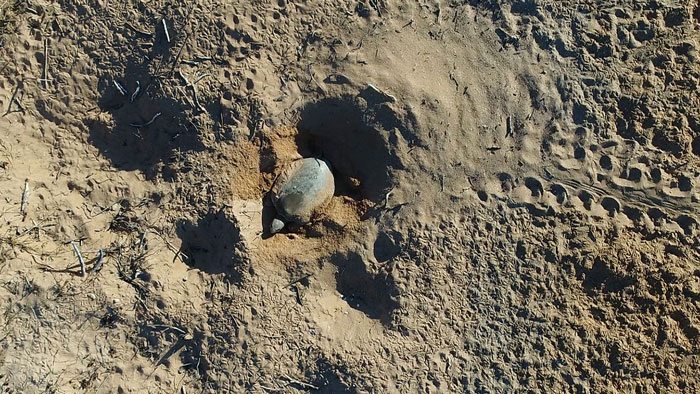 Hovering drones weren't a problem for nesting sea turtles. Other species were not so welcoming. Image courtesy Elizabeth Bevan.
Hovering drones weren't a problem for nesting sea turtles. Other species were not so welcoming. Image courtesy Elizabeth Bevan.
Drones have revolutionized wildlife biology — in large part because they give scientists a chance to observe natural behavior in a way they couldn’t before. For marine biologists, observations were generally limited to beachside lookouts or the limited sight lines of a surface vessel.
“We’re at the point where so many are using drones, even in these remote locations,” Bevan says. For her research in Australia, which was funded through a National Science Foundation/Australian Academy of Sciences East Asia and Pacific Summer Institutes Award, she flew all day, almost every day. She would cycle through a host of batteries, charging them through a solar panel draped over her tent frame.
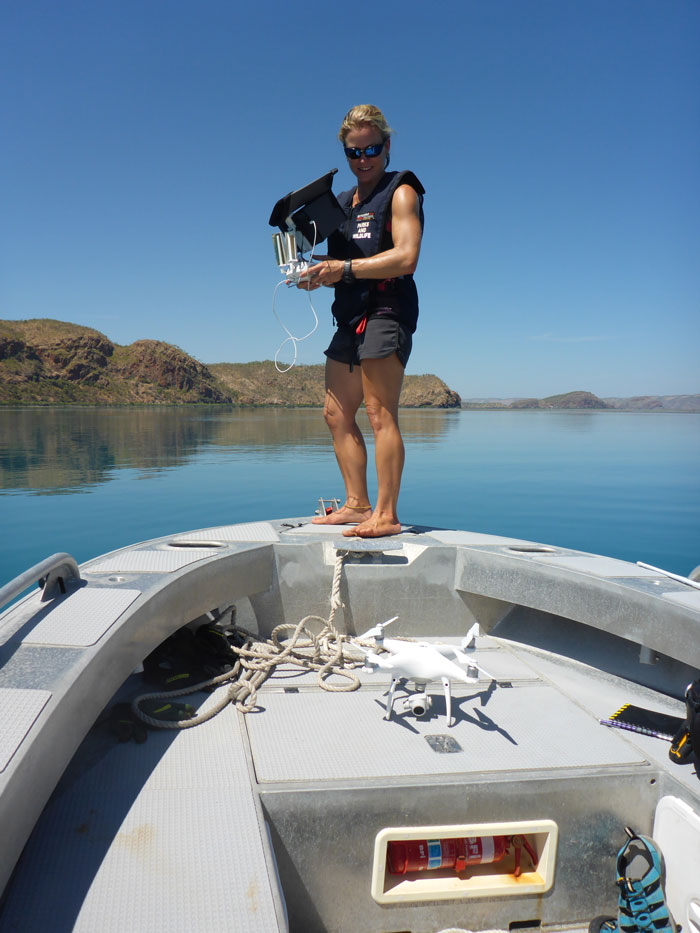 During her research trip, Bevan spent the majority of each day flying her DJI Phantom 4 Pro to collect video footage of turtles, often from small boats. Photo courtesy Elizabeth Bevan.
During her research trip, Bevan spent the majority of each day flying her DJI Phantom 4 Pro to collect video footage of turtles, often from small boats. Photo courtesy Elizabeth Bevan.
Buzz off
Quadcopters like Bevan’s Phantom have the virtue of being able to hover in place, documenting behavior through high-definition cameras. The closer the drone can get, the more detail that scientists can gather. (In addition to an optical camera, Bevan has used infrared FLIR imaging to monitor sea turtle activity on the beaches at night.) But as Bevan found, the machines, with their loud, buzzing motors, can disturb and stress wildlife.
“People say, ‘Well, just fly higher,’ but we can’t fly at 100 meters and observe the behavior of sea turtles” Bevan says. “There’s still so much we don’t know about sea turtles. Drones offer us a way to learn more.”
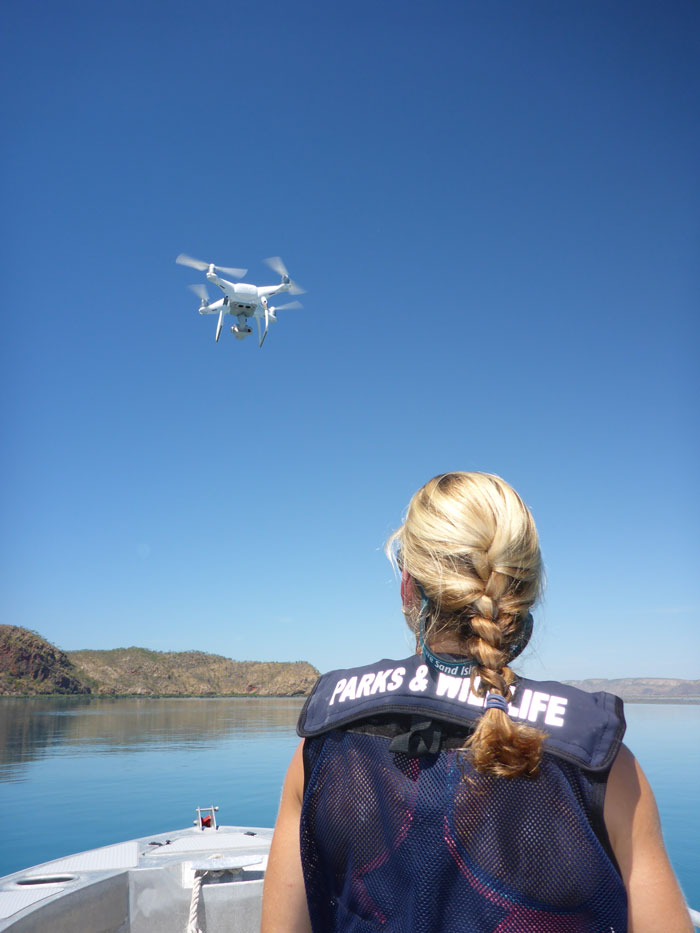 "There’s still so much we don’t know about sea turtles," Bevan says. "Drones offer us a way to learn more.” Photo courtesy Elizabeth Bevan.
"There’s still so much we don’t know about sea turtles," Bevan says. "Drones offer us a way to learn more.” Photo courtesy Elizabeth Bevan.
Bevan hopes her research will spur other studies. “This is a good place to start, but there’s still a lot of work that needs to be done,” she says. “Do the responses differ based on the size of the crocodile, for instance, or the time of year? In breeding season they may react differently.” Comparatively little is known about alert behavior or responses in sea turtles, and even less in crocodiles, she adds. “The literature describes everything from head movement to blinking. You can’t see blinking in the video I collected, but I would love to be able to add information to our repertoire.”
Forward — and back
Bevan, who is now applying for post-doctoral fellowships, would also love to continue her research in Australia. “There is so much potential,” she says. “I really want to make an impact with scientists in Australia, to fill in these information gaps.”
Many of the sandy islands she visited on the Timor Sea belong to Australia’s aboriginal peoples. A handful work on the islands as conservation rangers; when they saw the high-definition video from Bevan’s drone, they were excited. “They are stewards of this region and tied to it,” she says. “Everyone in the community is supposed to make a pilgrimage to their ancestral lands, but many are stuck inland, unable to travel. The connection fades, and they lose track of the stories that connect them to this land. When I showed them the footage, they said they could share it with their elders, to let their community know what they are doing and why it matters. Drones offer phenomenal perspective.”
Learn more about biology training at UAB.